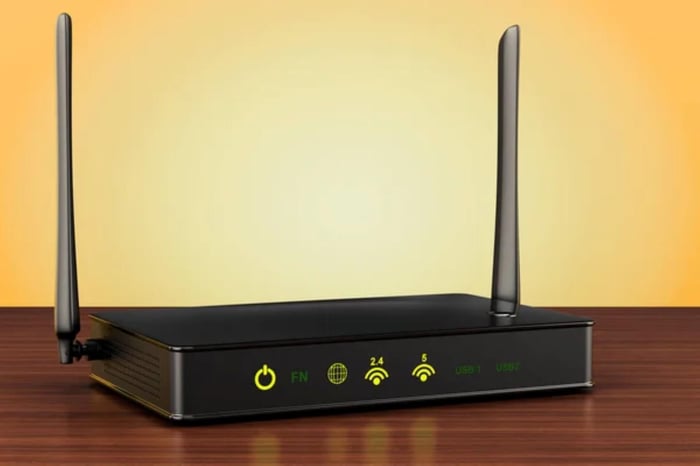How Much Wi-Fi Bandwidth Do I Need For Seamless Business Operation?

Every business needs access to the Internet in this day and age. However, every company has different needs regarding its Wi-Fi network. After all, smaller businesses have fewer employees who need access than bigger businesses.
Additionally, businesses in certain industries may rely heavily on the Internet to run their businesses, while others don't. Due to these factors, every business has different bandwidth needs. However, identifying exactly what your bandwidth needs are is essential to the operation of your business.
What Is Wi-Fi Bandwidth?
Wi-Fi bandwidth refers to the amount of data that can be transmitted over a wireless network at any given time. This includes both uploads and downloads, as well as streaming media.
Businesses need Wi-Fi bandwidth to ensure their employees have access to the resources they need online to work efficiently. A lack of bandwidth can result in sluggish performance, long loading times, and frequent connection issues, which can severely limit the productivity of an organization.
What Are The Benefits Of A High-Bandwidth Connection?
High-bandwidth connections provide several advantages that can help make businesses more efficient and productive. By choosing a connection with more bandwidth, companies can enjoy the following benefits:
- Download faster: With more bandwidth, you can download large files quickly and easily. This is especially important if your business shares or stores large amounts of data on the cloud.
- Support multiple online sessions: With a higher bandwidth connection, businesses can support multiple users accessing the web simultaneously. This allows for more collaboration and productivity among employees.
- Smoother user experience: Users will experience smoother video streaming and faster page loading with a high-bandwidth connection. This helps make sure that tasks are completed on time and reduces employee frustration.
Right Upload
Upload speeds refer to the rate at which data can be sent from your device to the Internet, while download speeds refer to the rate at which data can be received by your device from the Internet. The faster these speeds are, the more data can be sent and received at any given time.
So, businesses should make sure that they choose a network with speeds that are fast enough to support the needs of their organization.
How To Test Your Current Bandwidth
Once you know the upload and download speeds of your current Wi-Fi network, you can get a good idea of how much bandwidth you need. You can test your current bandwidth by running an Internet speed test or using a network monitoring tool. This will help you determine if your current connection is fast enough to support your business needs.
Once you know how much bandwidth you currently have, you can determine if you need more by doing the following:
- Count the typical Internet usage per device in Mbps: Most routers and firewalls can provide an estimate of how much bandwidth your devices use per month. Add up the total Mbps for all devices and compare it to your current connection speed to determine if you need more.
- Count the Internet usage by each employee: You can identify Internet usage by each employee by looking at their data usage for the month. This will give you a better idea of how much bandwidth your business needs to stay productive.
How Fast Should Your Business Internet Be?
Broadband Internet speed is defined by the FCC (Federal Communications Commission) as having at least 25Mbps for download speed. However, a fast connection is considered anything above 100Mbps.
With that in mind, a smaller business of around eight to 10 people will need between 100 and 500Mbps to download files quickly and stream UHD video on multiple devices. For bigger businesses with a greater dependence on using the Internet, you will need upwards of 1,000Mbps. For speeds that are faster than this, Fiber Optic connections are required.
Considerations In Determining Internet Speed Requirements
The last thing you'll want to do is purchase a plan that doesn't provide a fast enough connection for the needs of your business. On the other hand, you won't want to pay for more speed than you need. It is crucial to consider your business's Internet usage habits and determine its specific needs to ensure you get the right plan.
Here are some factors to consider when determining your business's Internet speed requirements:
- What type of business do you operate? Different businesses have different Internet speed needs. If your company develops software, you may need a faster connection to handle the large amounts of data that will be transferred.
However, if your business mainly focuses on customer service, you may just need something that can handle basic web browsing tasks.
- Do you regularly upload and download large files? If your business routinely sends or receives large files, you will need a faster connection to ensure that these operations are completed quickly and without any issues.
For instance, if your business creates video content, you'll need a fast connection to upload high-quality videos. If all you really download and upload are documents, then a slower connection may suffice.
- What are your Internet needs? If the only thing your employees are using the Internet for is to send emails or communicate with customers, then you don't need the fastest Internet available.
However, if your business is highly dependent on the Internet for tasks like video streaming or software applications, then it's vital to invest in a faster connection to ensure that these tasks can be completed quickly and without any issues.
- What role does fast Internet play in your business? If having a fast Internet connection is important to the success of your business, then investing in a faster connection will help you increase productivity and efficiency. This will also ensure that tasks are completed on time and without any delays.
- At any given time, how many employees will access the network? This is important because if too many people access your network simultaneously, it can slow down the connection for everyone. Make sure to calculate how many employees will be using it at any given time and adjust your bandwidth accordingly.
How To Optimize Your Wi-Fi Network
Just because you have a high-speed Internet connection doesn't mean it's being used to its full potential. There are still potential issues that can slow down your network. Here are some tips for optimizing your Wi-Fi network:
- Change the channel: If your network is on a congested channel, it can cause interference and slow down the connection. To fix this, you can change the channel to one with less traffic.
- Update access point firmware: Regularly updating your firmware will ensure it runs at peak performance. You should check the manufacturer's website to see if any new updates are available.
- Add more access points: Having too many devices connected to one access point can slow down the connection for everyone. Adding additional access points will help spread the load and ensure that all your devices are connected for peak performance.
- Limit connections: It may be helpful to limit the number of devices that can connect to your Wi-Fi network at any given time. This will help reduce interference and ensure that devices get a strong, fast connection. You can also password-protect your network to prevent unwanted devices from connecting.
- Monitor usage: You can monitor who uses the most bandwidth on your network, which will help you identify potential problems and allow you to adjust your connection speed accordingly. This will help you ensure that everyone in the office has a fast, reliable connection.
- Utilize a mesh Wi-Fi system as a last resort: A mesh Wi-Fi system can effectively cover large areas and ensure that everyone in the office has a strong connection only when wiring to each AP from a network switch is not available.
- Perform a wireless site survey: A wireless site survey and Wi-Fi network assessment can help identify any potential issues with your Wi-Fi network and give you detailed information on how to improve it. This will ensure that you provide the best possible connection speeds for your business.
Ways To Conduct Wi-Fi Troubleshooting
If you are having issues with your Wi-Fi network and it is not providing the speeds that you expect, here are a few steps you can take to troubleshoot the problem:
- Have a professional Wi-Fi assessment: A professional Wi-Fi assessment will help you identify potential network issues and recommend solutions to improve performance. For example, the assessor will be able to identify any weak spots in your network and suggest changes that can be made to improve your connection.
- Restart the device: Restarting the device can resolve some minor connection issues. For example, it can help clear up any memory issues causing your connection to slow down.
- Place the access point in a better location: If your access point is located in a poor spot, it can interfere with the connection and cause it to slow down. For instance, if it's too far away from the devices connecting to it, this can cause issues.
If it's located near walls or other obstacles, this can also interfere with the connection and cause it to slow down. Moving it closer to the area where you need coverage or placing it in an elevated location can help improve performance. - Replace old access points: If you are using older access points, they could be too slow to keep up with the demands of your network. Investing in newer, faster models can improve performance and ensure everyone in the office gets the speeds they need.
- Use Ethernet: Ethernet cables are the industry standard for connecting computers and other devices to networks. Switching to Ethernet cables can be a good solution if you are having trouble with your Wi-Fi connection. Using Ethernet cables to connect your access points will ensure you get the best possible speeds.
Operate With The Right Wi-Fi Speed Your Business Needs
Operating with the right Wi-Fi speed is essential for your business. A fast Internet connection will help you increase productivity and efficiency and ensure that tasks are completed on time. Investing in a faster connection will also ensure everyone in the office can access the speeds they need.
If you need help optimizing your Wi-Fi network, consider hiring a professional to conduct an assessment. At Hummingbird Networks, we can help assess your existing network and evaluate your business's Internet needs. We can also provide recommendations on optimizing your Wi-Fi network and ensuring it runs at peak performance.
Depending on your needs, the answer to how much Wi-Fi bandwidth is actually required can vary. But don't worry - we're here to help you figure it out.





